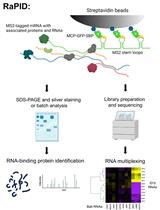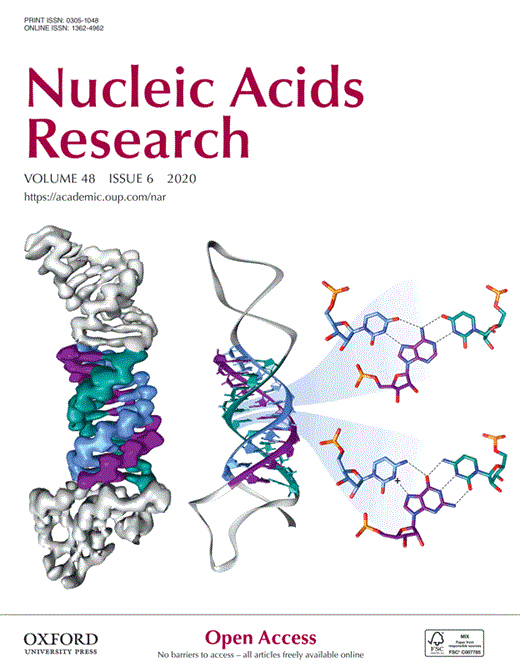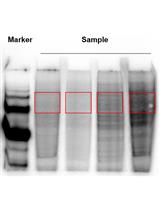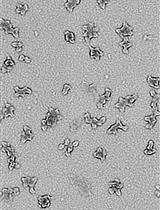- EN - English
- CN - 中文
Assessing the in vitro Binding Affinity of Protein–RNA Interactions Using an RNA Pull-down Technique
利用 RNA Pull-down 技术评价蛋白质-RNA 相互作用的体外结合亲和力
发布: 2022年12月05日第12卷第23期 DOI: 10.21769/BioProtoc.4560 浏览次数: 4029
评审: Gal HaimovichMarion HoggJian Chen

相关实验方案

基于适体的 mRNA 亲和纯化程序 (RaPID) 用于鉴定酵母中的相关 RNA (RaPID-seq) 和蛋白质 (RaPID-MS)
Rohini R. Nair [...] Jeffrey E. Gerst
2022年01月05日 5273 阅读
Abstract
RNA is a vital component of the cell and is involved in a diverse range of cellular processes through a variety of functions. However, many of these functions cannot be performed without interactions with proteins. There are currently several techniques used to study protein–RNA interactions, such as electrophoretic mobility shift assay, fluorescence anisotropy, and filter binding. RNA-pulldown is a technique that uses biotinylated RNA probes to capture protein–RNA complexes of interest. First, the RNA probe and a recombinant protein are incubated to allow the in vitro interaction to occur. The fraction of bound protein is then captured by a biotin pull-down using streptavidin-agarose beads, followed by elution and immunoblotting for the recombinant protein with a His-tag–reactive probe. Overall, this method does not require specialized equipment outside what is typically found in a modern molecular laboratory and easily facilitates the maintenance of an RNase-free environment.
Graphical abstract

Background
DNA is the fundamental molecule containing the genetic information of the cell. However, RNA and its interactions with proteins play an essential functional role in using this genetic information and translating it to biological implication(s). RNA is less stable than DNA, is often single-stranded, and forms secondary and tertiary structures such as hairpins, helices, stem-loops, and others. The structure and sequence of an RNA molecule are essential for the formation of specific protein–RNA complexes (Singh et al., 2019). Further, there are thousands of proteins in the cell responsible for recognizing specific RNAs, and these interactions may be critical for carrying out their role: they may promote or repress RNA degradation, as well as regulate the splicing, transport, and translation of mRNA strands (Corley et al., 2020).
Many proteins are subjected to dynamic post-translational modifications (PTMs), which impact the structure and function of the proteins being modified (Ramazi and Zahiri, 2021). These PTMs include, but are not limited to, phosphorylation, acetylation, ubiquitination, and methylation. Further, any mutation in protein sequence may block PTMs and prevent protein–RNA interactions (Zhang et al., 2020). Similarly, RNA may be subjected to chemical modifications that impact its structure. These RNA modifications include methylation of adenosine (N6-methyladenosine), guanine carbonyl addition (8-oxo-7,8-dihydroguanosine), and acetylation of cytidine (N4-acetylcytidine), among others (Boo and Kim, 2020). For these reasons, the study of protein–RNA interactions is necessary for improving our understanding of how RNA plays a role in vital cellular processes.
Traditionally, electrophoretic mobility shift assays (EMSA), fluorescence anisotropy, and filter binding have been used to study protein–RNA interactions (Majumder and Palanisamy, 2021). In contrast to traditional techniques, the proposed RNA pull-down method obtains in vitro binding affinity measurements (i.e., KD) for protein–RNA interactions (Figure 1A and 1B). Furthermore, RNA pull-down offers an approach in which an RNase-free environment is easy to maintain and uses standard immunoblotting for detection of bound protein. This contrasts with other protocols such as fluorescence anisotropy, which depend on specialized equipment, or other techniques, which are difficult to maintain an RNase-free environment. RNA pull-down can provide valuable information regarding protein–RNA binding affinities and analyze the effect of chemical modifications on these interactions. We have successfully applied this protocol to study the binding of nuclear polyadenylated RNA-binding (Nab) 3 protein RNA-recognition motif (RRM) with RNA and how point mutations to the lysine-363 residue affect this protein–RNA interaction (Lee et al., 2020).
Materials and Reagents
PCR tubes (Bio Basic Canada Inc., catalog number: BP541-S100)
P200 tip (Bio Basic Canada Inc., catalog number: BT224-YS)
Eppendorf tube (UltiDent Scientific, catalog number: 87-B150-C)
96-well microplate (Corning, catalog number: 351172)
PVDF membrane (GE Healthcare, catalog number: 10600023)
15 mL Falcon tube
Streptavidin agarose (Millipore Sigma, catalog number: 69203)
Bovine serum albumin (BSA) (Bioshop, catalog number: ALB001.100)
RNA probe (Sigma, sequence: 5’-[Btn]UUUCUUUUUUCUUAUUCUUAUU-3’; see Note 1)
DEPC (Bio Basic, catalog number: 1609-47-8)
Nonfat dry milk (Carnation, catalog number: n/a)
Clarity Western ECL substrate (Bio-Rad, catalog number: 170-5060)
Tris (Bioshop, catalog number: 77-86-1)
Tris-HCl (Bioshop, catalog number: 1185-53-1)
Hydrochloric acid (HCl) (Anachemia, catalog number: CA11020-884)
Sodium hydroxide pellets (Bioshop, catalog number: SHY700.2)
NaCl (Bioshop, catalog number: SOD002.1)
DTT (Bioshop, catalog number: DTT001.25)
EDTA, disodium dihydrate (Bioshop, catalog number: EDT001.500)
Glycerol (Bioshop, catalog number: 56-81-5)
SDS (BioShop, catalog number: SDS001)
Tween-20 (Bioshop, catalog number: TWN510.500)
Bromophenol blue (Sigma, catalog number: B-6896)
2-Mercaptoethanol (Sigma, catalog number: M3148)
HisProbe-HRP conjugate (Thermo Fisher Scientific, catalog number: 15165)
Protein assay dye reagent concentrate (Bio-Rad, catalog number: 5000006)
Stock solutions (see Recipes)
Pull-down buffers & solutions (see Recipes)
Western blotting & other buffers (see Recipes)
Equipment
100 mL beaker
500 mL beaker
Magnetic stirrer
Sorvall Legend Micro 21 centrifuge (Thermo Scientific, catalog number: 75772436)
Mini centrifuge (Fisher Scientific, catalog number: 05-090-100)
Gel Doc XR+ imaging system (Bio-Rad, model: Universal Hood II)
Thermocycler (Bio-Rad, model: ICycler Thermal Cycler)
Rotator (Kylin-Bell Lab Instruments, model: BE-1100)
-80 °C freezer (Thermo Scientific, model: 990)
Software
ImageJ 1.50c software
GraphPad Prism v7.00
Procedure
文章信息
版权信息
© 2022 The Authors; exclusive licensee Bio-protocol LLC.
如何引用
Chopra, A., Balbous, F. and Biggar, K. K. (2022). Assessing the in vitro Binding Affinity of Protein–RNA Interactions Using an RNA Pull-down Technique. Bio-protocol 12(23): e4560. DOI: 10.21769/BioProtoc.4560.
分类
生物化学 > RNA > RNA-蛋白质相互作用
分子生物学 > RNA > RNA-蛋白质相互作用
您对这篇实验方法有问题吗?
在此处发布您的问题,我们将邀请本文作者来回答。同时,我们会将您的问题发布到Bio-protocol Exchange,以便寻求社区成员的帮助。
Share
Bluesky
X
Copy link










